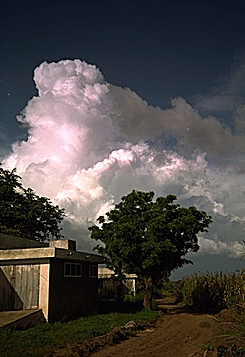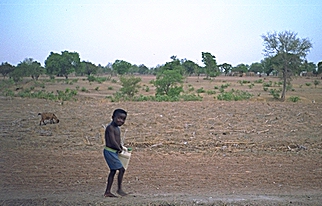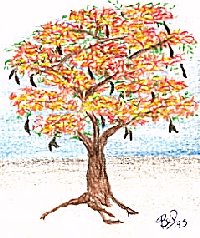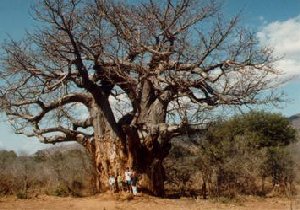

Weather and Environment |

|
There are three distinct seasons: Rainy, Dry, and Hot.
The rainy season starts in May and ends in September. This short season only allows for one crop cycle. Rainstorms usually last no longer than an hour and are very violent. Those storm clouds above are building into a big storm. Flash floods are common and ravines usually dry, turn into turgid and turbulent rivers. The rainy season only allows for one crop cycle.
As October rolls around and the Dry season starts, the temperatures drop from the high 90's down to the mid 80's. The clouds disappear from the sky and the relative humidity drops to 10%! Even more dramatic is the dusty wind off of the Sahara called the Harmattan. It coats everything not moving too quickly with a thin layer of white dust. On particularly bad days visibility is reduced to 100 meters and the usually unforgiving Sun is simply a whitish haze in the sky.

|
On the left is Robert going to the borehole to collect his water. You can see how dry and brown the land is! Also behind Robert is a typical goat that eats everything and anything. (They especially like to eat young mango tree seedlings that you plant. The only good goat is the one in your groundnut stew.) |
|
By March the Harmattan dies down and the Sun is directly overhead. Temperatures can easily reach 110 °F and life slows to a crawl. In the mid-day heat everyone finds their favorite shade (usually a mango tree which also happens to be bearing fruit this time of the year) and tries not to move to much. The first sign that the hot season is coming to a close is the blooming of the flamboyant tree. It burst with orange, yellow, and red flowers when almost everything around it is brown and tan. When the first rain falls and softens the hard, desiccated earth, people start getting ready for a new farming season and the cycle continues.
|

|
|
The land around Navrongo and Lawra is very flat and intermitantly populated with trees. Much of the low-lying brush has been cleared due to farming and firewood collection. The most common trees found around Navrongo and Lawra are either sheanut or baobob. The sheanut tree has a soft pulpy fruit with a hard seed. The hard seed is crushed and used for oil. The baobob is often called the "upside down tree." The barrel-like trunk may reach a diameter of 9 meters (30 feet) and a height of 18 m. The large, gourdlike, woody fruit contrains a tasty mucilaginous pulp. A strong fibre from the bark is used locally for rope and cloth. The trunks are often excavated to serve as water reserves or temporary shelters. |

|
| It's hard to see but the women on the right is getting firewood for her family. Most women have to walk for many miles to get their firewood. Slowly but surely the land is being cleared of its trees. |

|
 Back to the Main HomePage
Back to the Main HomePage

© MCMXCVIII All Rights Reserved